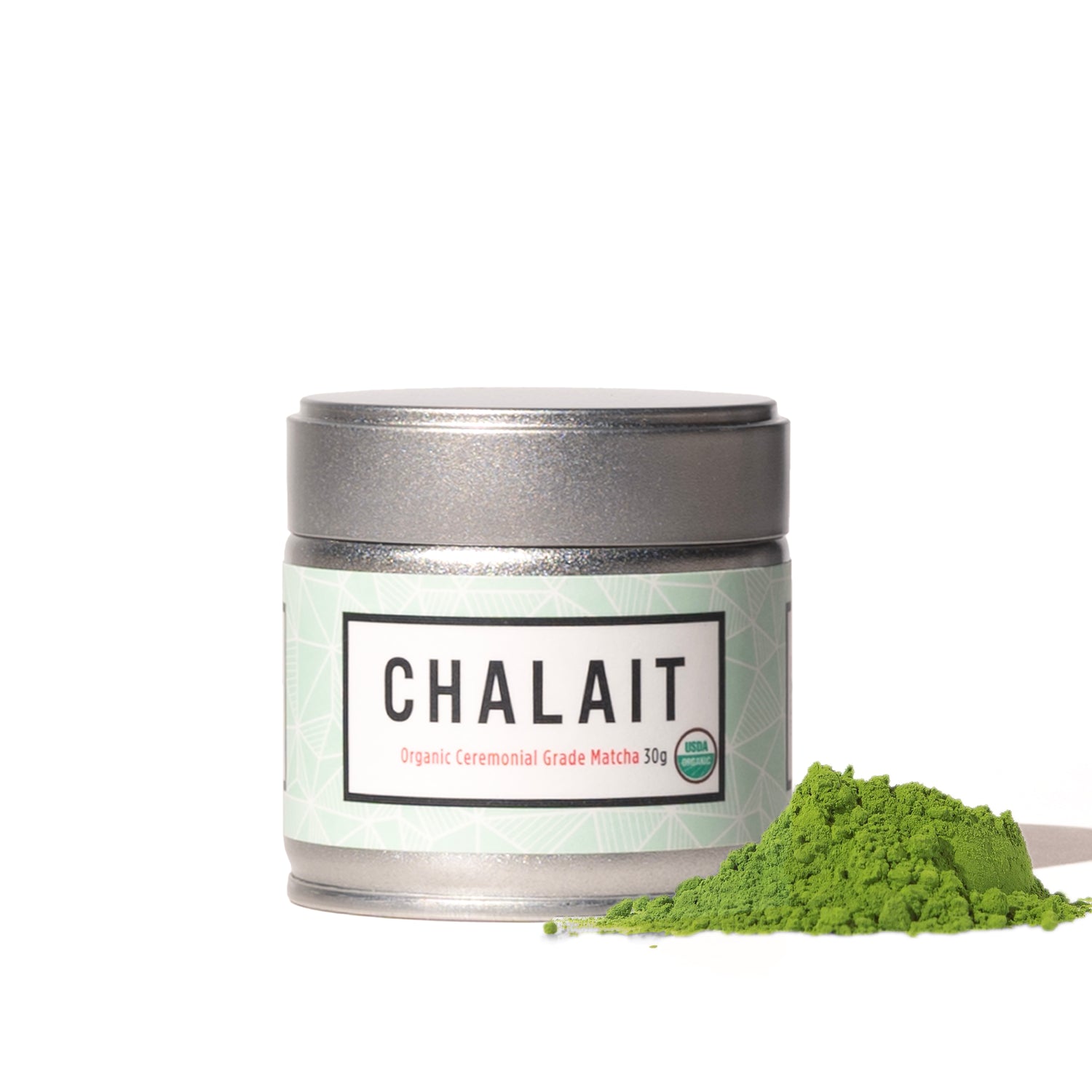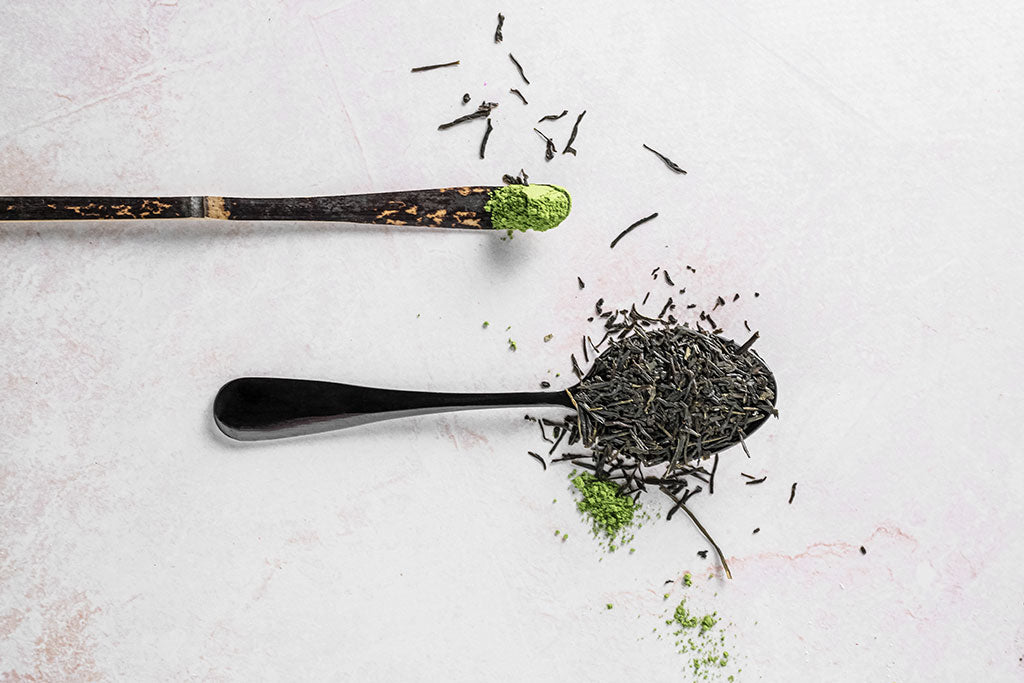There are many things to consider when choosing the perfect green tea to suit your lifestyle and dietary requirements. Matcha is just one out of hundreds of different green tea types. But is matcha the same as green tea you’d steep in a teapot? Or can it offer additional benefits? How does matcha compare to some of the most popular types of green tea? This article is going to help you understand all the differences.
In fact, the difference between matcha and green tea is actually huge.
1. Growing methods
All green tea, including matcha, is made from leaves of Camellia sinensis plant. Tea leaves for making green tea are usually harvested from tea plantations rather than wild tea bushes. Matcha is always grown on tea plantations, and it undergoes one more mandatory step – shading. Tea plants are shaded for 3-4 weeks before harvesting to achieve a special flavor profile, good nutrient content and vibrantly green color.
Other famous shaded green teas are Kabusecha and Gyokuro, both from Japan.
2. Processing methods
What makes any green tea green is the “kill green” step that stops the oxidation and preserves the color, flavor and nutrient content of raw tea leaves. Green teas are usually either steamed or pan-fired, which gives them a unique vegetal and grassy or nutty and toasted flavor. Matcha is steamed, de-veined and de-stalked, leaving only small gentle dark green leaf flakes that are further ground into powder. No other green tea undergoes this process.
Sencha can be powdered too, but it won’t undergo the shading or de-stalking process.
3. Flavor differences
Green tea may have a whole range of flavors, from grassy to nutty, even roasted and mossy. Matcha too, may have different flavors– from sweet and umami rich, to fresh and grassy. Unlike green teas, every matcha will always have sweetness and umami notes. Matcha will also have a full and creamy texture without transparency.
When prepared traditionally, matcha has a much stronger flavor compared to other green teas.
4. Caffeine content
Caffeine content in green tea will depend on dozens of factors – from the tea plant variety, to growing and processing methods, brewing technique and storing conditions. Green tea may have very little caffeine (for example, kukicha and hojicha tea) and high levels such as in gyokuro tea. It’s impossible to say how much caffeine a cup of green tea will provide without testing it, but it’s possible to assume how much caffeine a cup of matcha contains.
First, the shading process that teas like kabusecha, matcha and gyokuro undergo will increase the caffeine content. That same shading process will increase the L-theanine content too, offering both energy boosting and calming properties. Result? Feeling refreshed with no jitters.
For example, a cup of gyokuro may provide over 100 mg because – it’s a shaded tea and prepared using at least 5 grams of tea leaves per 100 ml of water. This gives a very strong infusion. For making other green teas, you will need to use 2-3 grams of green tea per cup of water and there’s usually no shading involved, resulting in a weaker infusion – from 10 to 50 mg per cup. To make a serving of matcha, you’ll need 1.5-2 grams of matcha powder, giving approximately 45-60 mg of caffeine. In fact, studies showed that matcha is the best source of caffeine among green teas [1].
One serving of matcha may provide the same amount of caffeine as one shot of espresso.
5. Health benefits
All green teas are made using similar techniques. The crucial step in producing green tea is the “kill green” step that stops the oxidation and preserves the color, flavor and nutrient composition. Matcha undergoes the same processes, with a few additional steps that increase the caffeine and amino-acid content. These steps are shading the tea plant from direct sunlight, removing all stalks and stems and powdering the tea.
All green teas contain chlorophyll, caffeine, EGCG, L-theanine and other amino acids, vitamin and minerals. However, just like caffeine, other compounds need a specific water temperature and steeping time for optimal extraction. With matcha, there’s no steeping involved. While the water temperature is still important, you’ll be ingesting the whole leaf, and not only the extracted nutrients.
Matcha is a great source of rutin and Vitamin C. The concentrations of these two compounds are higher in matcha than in other green teas [2]. Rutin is a flavonoid that may have a beneficial effect on endocrine, central nervous, cardiovascular, respiratory and gastrointestinal system [3].
Because of unique growing and processing methods, matcha may provide more benefits than classic green teas.

6. Brewing technique
All green teas are best brewed at 158-194°F, depending on the type. Higher temperature will improve the nutrient extraction and enhance the antioxidant properties for both green tea and matcha. However, if you use boiling water, both green tea and matcha will become bitter.
To make matcha you will need a matcha bowl, matcha whisk and a matcha scoop, and to make a delicious cup of green tea you will need a teapot or a strainer. Matcha is whisked rather than steeped, so there’s absolutely no waste left. Another benefit? It’s unlikely you will forget to drink it, which is often the case with a cup of regular green tea.
With a bit of practice, making matcha is very easy.
7. Ease of use
Once you learn how to make matcha using traditional utensils, brewing becomes very easy. In fact, it’s much easier than making a cup of regular green tea as there’s no steeping involved. Or, you can simply add matcha to a cup of cold water and shake/stir, which is not an option with loose green tea or tea bags. Matcha is amazing for adding to desserts too. Other green teas are rarely used for cooking or making treats, because they won’t add much flavor or color as matcha.
Also, matcha tastes delicious with milk, which is rarely a case with other green teas. Only a few types can be used for making lattes, while all matcha teas are delicious with milk or milk alternatives.
Matcha is much more versatile than regular green teas and can open a whole new world of unique desserts.
Matcha vs. specific green tea types
Sencha, hojicha, genmaicha and gunpowder tea are some of the most popular green teas worldwide. How do they compare to matcha?
Hojicha vs matcha
Hojicha is a type of Japanese roasted tea, and it’s a complete opposite to matcha. It’s usually made from mature tea leaves, but technically, any Japanese roasted green tea can be made into hojicha – including tencha tea leaves. Hojicha is usually lower in caffeine than regular green tea and has a lower antioxidant value than other green teas. It has a strong nutty flavor and it’s dark in color. Another interesting fact? Hojicha can be powdered too.
Sencha vs matcha
Depending on the growing and harvesting method, besides gyokuro, sencha is a green tea type that’s the closest to matcha. A specific type of deep-steamed (fukamushi) sencha has a very vivid deep green color and lots of sweetness and depth. Sencha may be shaded for a couple of days too, which will increase the umami flavor. However, sencha is usually not prepared with milk and will have a lower levels of caffeine and L-theanine than matcha.

Gunpowder vs matcha
Gunpowder is a type of Chinese green tea that’s widely available around the world. This tea is often very strong and deep, with pronounced bitterness. Gunpowder may provide medium to high caffeine. Unlike matcha, it has a very intense yellow color and much less freshness. However, it’s also one of the green teas that may go well with milk.
Genmaicha vs matcha
Genmaicha is a type of Japanese green tea with toasted and popped rice, sometimes called a popcorn tea. Genmaicha can be made with sencha, bancha, gyokuro or other types of tea. Gyokuro genmaicha will have more similarities with matcha than bancha genmaicha, simply because gyokuro is also a shaded tea. However, it will always contain less EGCG, L-theanine and caffeine than pure green tea, and especially less than matcha.
Matcha vs Green Tea Recap
Although matcha is a type of green tea, it’s unlike any other tea. It’s prepared differently, has the same nutrients but in different ratios than other green teas, and it’s much more versatile, especially if you want to experiment with lattes, milk teas or baking. Which one is better? All green teas may provide significant benefits and delicious flavors, but matcha may have a slight edge over other types of green tea.


